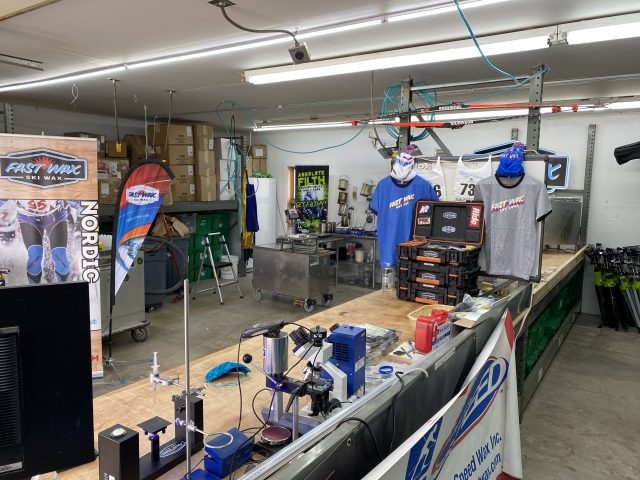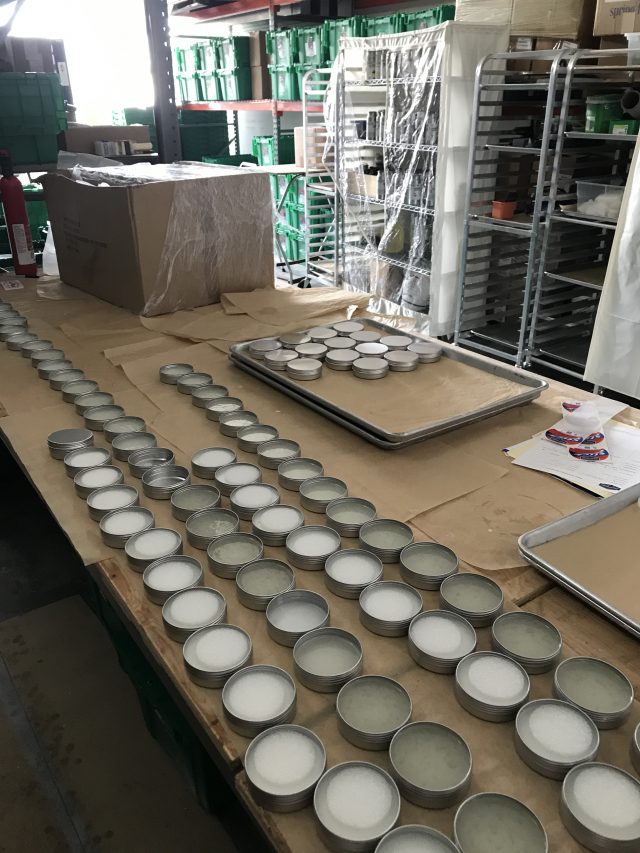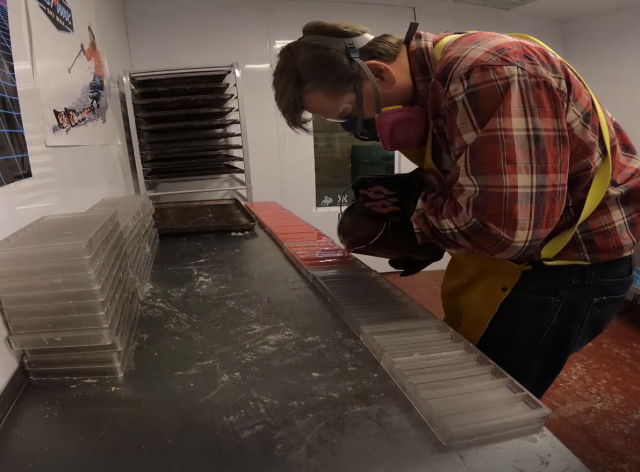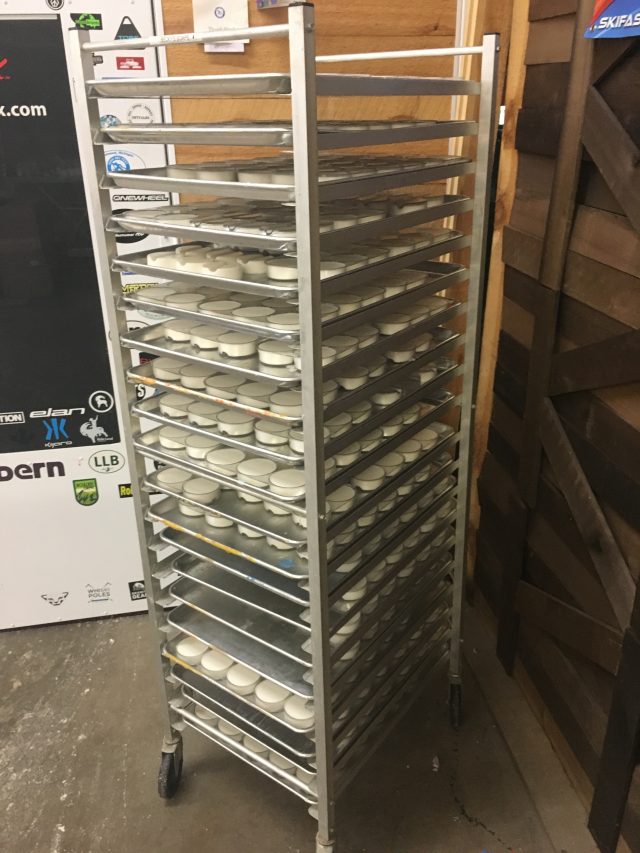Editor’s note: FasterSkier is fortunate to have the sponsorship support of Fast Wax; therefore, we are proud to highlight the innovative spirit that Fast Wax brings to the cross-country skiing marketplace. This article is less an endorsement of one company’s products than it is a recognition of the hard work undertaken by so many companies in the the ski industry.

Dan Meyer likes to innovate. So naturally, as he became more interested in Nordic skiing, that quality extended to the wax he put on his skis. In 1986 Meyer created the first iteration of Fast Wax, one of the only U.S. made nordic wax brands. Meyer, a chemist with a background in polymer science, continued to develop and grow Fast Wax from his home in Minnesota for the next 32 years.
In 2018, Fast Wax founders Dan and Rosie Meyer sold their operation to the Kirt family. Casey Kirt had spent 25 years working in information technology at a large mortgage company in the Midwest and he was ready for a career change. The sale closed in just ten days and Kirt immediately quit his full time job and started working on Fast Wax.
“I love making stuff,” Kirt said, “and what Dan developed is something special.” For Kirt and his wife Katie, their incentive for buying the company was spurred on by the exciting challenge of modernizing Fast Wax and expanding the brand. The Meyers kept the operation contained to fit within their garage and passed along the wax recipes on 3×5 note cards when they sold the business.
“They weren’t very sophisticated and they didn’t want to be,” Kirt said. “It was really just a part-time hobby business. They enjoyed working with each other, it was fun to see that.” Kirt has invested a lot of time and energy in making the business scalable while maintaining the tradition of family members working together to create wax.
When Kirt’s daughter began college at Montana State University in Bozeman, Casey and Katie Kirt relocated there, bringing the Fast Wax headquarters with them. Now they have a shop in the Belgrade area where wax manufacturing happens in the spring when the temperature is most ideal. The whole family chips in on the wax-making process. “We’ll sit Grandma at the table and she can start putting on labels,” Kirt said.
Kirt has taken advantage of his business’ proximity to the university, working with students and professors there in various ways. They use labs on campus for quality control testing, Kirt collaborated with the mechanical engineering program to make a wax-pouring robot and he is currently talking with faculty about the possibility of developing the first American-made kick wax.
In simplified terms, Kirt explained that the Fast Wax product is made up of different types of waxes blended together to create certain properties for specific hardness or temperature range. “Ski wax is a very inert process,” he said. “We want to make sure all the elements in that wax are melted and mixed.” Ensuring proper mixing and heating is crucial for the wax’s success.

In 2019, the International Ski Federation announced a ban on all fluorinated ski waxes in FIS competitions. Implementation of the ban has been delayed for the third year running, but Fast Wax is still taking steps to ensure their waxes will comply with the impending ban. Kirt said this was part of the reason the Meyers wanted to sell the company, because they didn’t want to deal with testing a lot of new additives.
When Kirt took ownership of the business, he hired a chemical engineer to start tests and build a catalog of stuff that showed promise. They built a 70-foot-long rain gutter, filled it with snow, waxed skis and measured the time it took for a ski to travel the distance. They’ve now isolated three additives from obscure industries that Kirt says they feel really excited about.
One is a by-product from the agriculture industry that is re-purposed for use in the Fast Wax “everyday consumer” wax. Another is very water repellent and is used in the race wax line. A third is created from super-fine ground up metal that Kirt says creates “crazy durability.”
In coming up with alternative additives Kirt said, “It’s gotta be safe for the environment and safe for the skier, next it’s got to be affordable for the skier.” He said he’s happy the industry has shifted towards using more friendly chemicals.
“This fluorocarbon transition has really reset the playing field for everybody,” Kirt said. “We’re here at the grassroots, having people try our product and convincing themselves that, yeah this is a solid fluorocarbon substitute.”

For Kirt, it all comes down to scalability. His goal is to extend Fast Wax’s reach from coast to coast. “We’re one of the only U.S. Nordic brands,” Kirt said, “We have the capacity to service large customers.” Given the brand’s Midwest origins, Fast Wax is more prevalent there.
The spring after the Kirts purchased Fast Wax from the Meyers, Casey and his wife were in the company van at a boat launch in a tiny town in Wisconsin when a man approached them to say, “I love Fast Wax, I’ve been skiing on it for five years.” Kirt was blown away.
“That’s who I want to be,” he said. “I don’t want to be the big flashy brand that’s got all these high end skiers that we’re paying millions of dollars, I’d rather keep my ski wax prices low and allow casual skiers or people just getting into the sport to have money leftover after buying all the gear to buy some Fast Wax and go have a fun time.”
Looking to the future, Kirt plans to do just that. He wants to keep customer costs low and enable skiers to spend time on the trails or the mountain, not in the wax room. Like Fast Wax’s founder, Dan Meyer, Kirt continues to innovate.
“We’re not just sitting on our haunches now that we found these new replacements for fluorocarbons,” he said. “We continue to investigate and research other materials that may be better for the environment, safer for the skier. We want to continue understanding what the marketplace has to offer and we will present that to customers.”

Ella Hall
Growing up in Washington’s Methow Valley, Ella was immersed in skiing and the ski community from a young age. From early days bundled in the pulk, to learning to ski as soon as she could walk, to junior racing, a few seasons of collegiate racing, and then to coaching, she has experienced the ski world in many forms. Now, as a recent graduate from Dartmouth College, she finds herself living in France splitting her time between teaching English at a university in Lyon, avidly following ski racing (and now writing about it!) and adventuring in the outdoors as often as possible.



